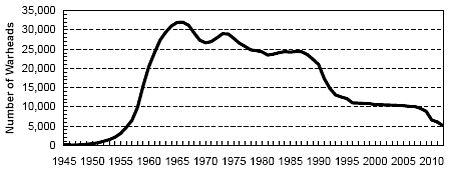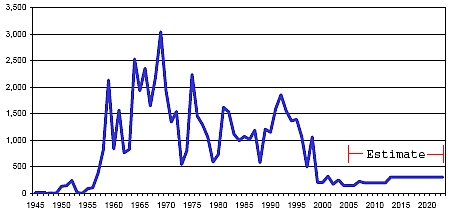Estimates of the US Nuclear Weapons Stockpile, 2007 and 2012
 |
Click on figure to open full fact sheet. For an updated stockpile estimate, go here.
The Bush administration announced in 2004 that it had decided to cut the nuclear weapons stockpile “nearly in half” by 2012, but has refused to disclose the actual numbers. Yet a fact sheet published by the Federation of American Scientists and Natural Resources Defense Council estimates that the stockpile will decline from approximately 9,938 warheads today to approximately 5,047 warheads by the end of 2012.
FAS and NRDC publish the fact sheet now because Congress is considering whether to approve a proposal by the administration to resume industrial production of new nuclear weapons, and because government officials have told Congress that production of new warheads will make it possible to reduce further the size of the stockpile in the future.
The fact sheet estimates are based on information collected by the authors over several decades about production, dismantlement and operation of US nuclear weapons.
The 2012 stockpile of 5,000+ warheads represent a significant reduction from the 24,000 warhead stockpile of the 1980s (and the all-time high of 32,000 warheads in 1966), but it still a very big post-Cold War stockpile. No other country with nuclear weapons is known to plan a stockpile that big. The only other country with several thousand warheads in 2012 will be Russia, but it probably only maintains a large stockpile because the United States does.
|
History of US Nuclear Weapons Stockpile, 1945-2012 |
 |
| The US nuclear weapons stockpile varied greatly since the attacks on Hiroshima and Nagasaki in 1945. From an all-time high of approximately 32,000 warheads in 1966, the stockpile is estimated to return to its 1957-level by 2012, but with vastly superior capabilities. |
Most of the 2012 stockpile will not be counted by the SORT treaty signed by the United States and Russia in 2002. That treaty only counts “operational deployed strategic nuclear warheads,” which are not to exceed 2,200 by the end of 2012. The FAS/NRDC fact sheet estimates that 2,192 US warheads will be counted by SORT, leaving another another 2,855 “invisible” warheads. The number of uncounted warheads will be even greater in Russia because it retains many more non-strategic nuclear weapons than the United States.
Approximately half of the warheads in the 2012 stockpile will be active and ready to launch on relatively short notice. This indicates that US nuclear posture planning 17 years after the end of the Cold War is still dominated by a nuclear warfighting mentality.
Secret Dismantlements
Dismantling the nearly 4,900 retired warheads will take much longer to accomplish than the stockpile plan. By 2012, approximately 3,660 of the retired warheads will still be in storage. The reason is that the US dismantlement facility at Pantex in Texas is busy extending the lives of the many warheads the administration has decided must remain in the stockpile. Dismantlement will not be a priority for the next decade. Under current plans, dismantling the backlog of retired warheads will take until 2023, at an average rate of some 272 warheads per year.
Nuclear dismantlements, the National Nuclear Security Administration (NNSA) told Congress in 2006, represent “a key element of our strategy to ensure that stockpile and infrastructure transformation is not misperceived by other nations as ‘restarting the arms race.'” In fact, NNSA explained, “our commitment to a smaller stockpile is made concrete by our record of accelerated dismantlements.”
That record is not very impressive. Although the administration says it plans to dismantle 50 percent more warheads in 2007 than in 2006, the actual numbers are small – probably about 200 warheads per year – and a far cry from the average of 1,100 warheads dismantled at the Pantex Plant each year during the 1990s. In fact, the Bush administration has dismantled the smallest number of nuclear weapons of any US administration since 1957, a record that is expected to continue through 2023 under current plans (see figure below).
|
Estimated US Nuclear Weapons Dismantlements, 1945-2023 |
 |
| US dismantlement of retired nuclear warheads has fluctuated greatly over the years from a high of more than 3,000 in 1969. The Bush administration has demonstrated the lowest warhead dismantlement rate of any administration since 1957. |
While one part of the administration is trying to use opaque dismantlement numbers as a means to assure the world, another part is working to keep the dismantlement record secret. During much of the 1990s, the Department of Energy readily disclosed how many of each types of nuclear warhead has been retired. In 1994, DOE declassified numerous years of stockpile data. But in 1999, a new directive issued by the Clinton administration ended that practice and ordered that dismantlement numbers must be kept secret. According to DOE officials, the ban was necessary because the reason for retiring additional weapon systems may not be unclassified, and because information must be protected that would reveal the size of the current stockpile.
“Dismantlement rates now could reveal, for example, the actual decline in stockpile numbers, which would reveal classified information because the size of the stockpile is classified,” as one senior DOE official explained. To implement the directive, an interagency agreement was made between DOE and DOD to protect future weapon dismantlement data.
This policy assumes it would severely damage US national security if potential adversaries knew how many nuclear weapons the United States have. But that assumption appears to be a legacy of the Cold War when massive nuclear armies stood poised to fight nuclear battles and details about warhead numbers could potentially make a difference. It is difficult to see why disclosing these numbers would matters today.
What’s the End Plan?
The current stockpile plan is based on a pledge made by President Bush in 2001 only to maintain “a credible deterrent with the lowest-possible number of nuclear weapons consistent with our national security needs.” This pledge is frequently repeated by government officials in testimonies to Congress.
Although the pledge sounds good, it doesn’t necessarily change anything. After all, when has the United States not had a policy of maintaining a credible deterrent with the lowest-possible number of nuclear weapons consistent with national security needs? That was the policy when there were 32,000 and 24,000 nuclear warheads in the stockpile. It was the policy when the current stockpile of nearly 10,000 warheads was set in 1994, and it is the policy for the 5,000 warhead stockpile planned for 2012.
What should impress Congress now, however, is that the size of the stockpile planned for 2012 is based on a level of deployed warheads and a force structure that was set a decade ago in 1997 in preparation for what was then known as the START III agreement. Although the Bush administration rejected the treaty as a Cold War relic, it embraced the force level and incorporated it into the 2001 Nuclear Posture Review and the SORT agreement signed with Russia in 2002 – minus verification and irreversibility. One decade later, no new overall force goal has been set.
The stockpile numbers speak to what the administration’s real long-term intentions are, and they indicate that a review of US nuclear policy is long overdue. The public perception of the size of the nuclear arsenal is highly inaccurate, according to a recent poll, and the news media frequently misreport on the size of the stockpile. Allies need to be reassured that US nuclear policy is not moving in the wrong direction, a concern they share now according to a recent study. And transparency is needed to avoid that other nuclear powers make the wrong conclusions about US long-term intentions.
Background: FAS/NRDC Fact Sheet
A military depot in central Belarus has recently been upgraded with additional security perimeters and an access point that indicate it could be intended for housing Russian nuclear warheads for Belarus’ Russia-supplied Iskander missile launchers.
The Indian government announced yesterday that it had conducted the first flight test of its Agni-5 ballistic missile “with Multiple Independently Targetable Re-Entry Vehicle (MIRV) technology.
While many are rightly concerned about Russia’s development of new nuclear-capable systems, fears of substantial nuclear increase may be overblown.
Despite modernization of Russian nuclear forces and warnings about an increase of especially shorter-range non-strategic warheads, we do not yet see such an increase as far as open sources indicate.